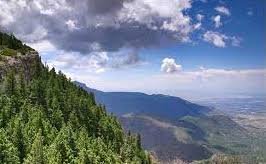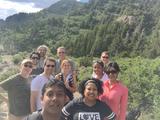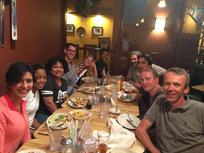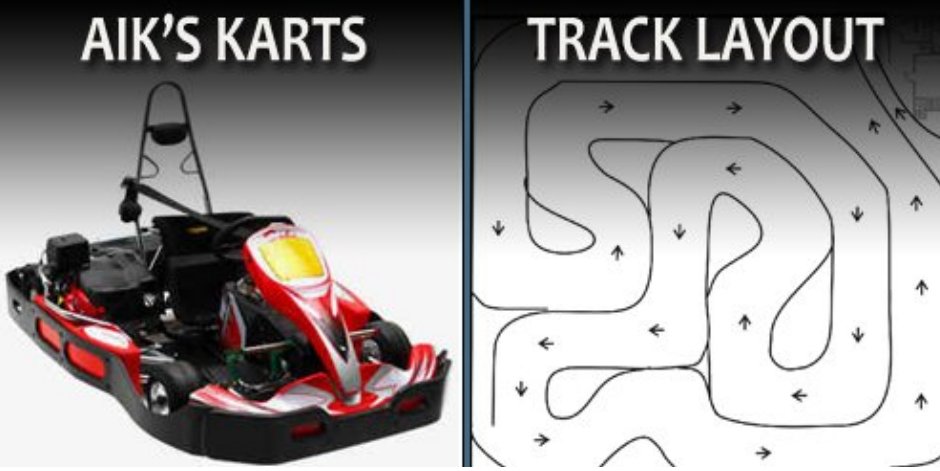LAMMPS WWW Site
August 2015 LAMMPS Users' Workshop and Symposium
The fourth LAMMPS workshop and symposium for users and developers was
held in Albuquerque, NM on August 5-7, 2015, at the UNM Continuing
Education Building, (1634 University Blvd. NE,
map).
We thank the DOE/NNSA ASC program for financial support in hosting the
workshop and industrial partners Materials Design and Scienomics for
graciously providing lunches, snacks, and drinks for the attendees.
PDFs for most of the talks, posters, and tutorial presentations can be
viewed or downloaded via the links below.
Video of most of the main sessions talks are available on Moodle,
and can be accessed as follows:
- Point your browser to http://moodle.mindmodeling.org/index.php
- Click on "Login as a guest"
- Enter LAMMPS in the search field
- Click on "LAMMPS Users' Workshop and Symposium"
- Enter the password "lammps_2015"
A list of workshop attendees can be found here:
attendees

Click on image for larger version.
Click here for full-size image
The workshop program included a keynote speaker and 6 invited talks:
There were also display booths from these industrial partners:
- CreativeC
- J-OCTA from JSOL Corporation
- Materials Design
- Scienomics
Wednesday August 5, 2015
8:30 AM - 12 PM Beginners' Tutorial (chaired by Matt Lane)
An introduction to LAMMPS designed to get attendees running and using
LAMMPS quickly.
Overview: This tutorial is an introduction to LAMMPS designed to get
attendees up and using LAMMPS quickly. Beginning with downloading and
building, these tutorials will highlight major features of the code
with an emphasis on examples and demos. Bring your laptop computer
with LAMMPS already installed if at all possible. Also have other
relevant software already installed if you wish to use it: MPI (MPICH
or OpenMPI), VMD or AtomEye or Ovito,
Pizza.py, a movie making software
(e.g. QuickTime or ImageMagick). If you have a Windows laptop, Cygwin
will be useful. There will be opportunities for discussion, hands-on
work, and questions.
8:30 Welcome and agenda: Matt Lane, Sandia
(PDF)
8:35 General LAMMPS overview: Aidan Thompson, Sandia
(PDF)
8:50 Download, build, and run LAMMPS: Matt Lane, Sandia
(PDF)
(PDF)
9:10 Basic output post-processing: Aidan Thompson, Sandia
(PDF)
9:25 Visualization of results: Matt Lane, Sandia
(PDF)
9:40 break
9:50 LAMMPS input scripts, syntax and rules: Steve Plimpton, Sandia
(PDF)
10:15 LAMMPS capabilities - force fields, ensembles, electrostatics,
fixes and computes, load-balancing, on-the-fly viz, GPU acceleration:
Steve Plimpton, Sandia
10:45 Hands-on activity - run the simple examples that come with
LAMMPS: Steve Plimpton, Sandia
11:00 break
11:10 Case study 1 - Interatomic potentials and KIM: Ryan Elliott,
Univ of Minnesota (PDF)
11:40 Case study 2 - Monitoring chemical reactions using on-the-fly
molecular species analysis: Ray Shan, Sandia
(PDF)
12 PM - 1 PM Boxed lunches in lobby
Official start of workshop
1 PM - 5 PM General session of technical talks (chaired by Aidan
Thompson)
- 1:00 Steve Plimpton, Sandia
- Welcome and what's new in LAMMPS (PDF)
- 1:30 (keynote) Eduardo Bringa, Universidad Nacional de Cuyo
(Mendoza, Argentina)
- Computational and modeling challenges to model materials under
extreme conditions (PDF)
- 2:00 Enrique Saez, Los Alamos National Lab
- Sublattice parallel replica dynamics (PDF)
- 2:15 Ray Shan, Sandia
- Charge equilibration for many-body
potentials (PDF)
- 2:30 Hengjia Wang, Clemson University
- Calculations of lattice vibrational mode lifetimes using Jazz: a new
Python wrapper for LAMMPS (PDF)
- 2:45 Matt Lane, Sandia
- Molecular modeling of high-pressure ramp waves in
tantalum (PDF)
3:00 break
- 3:15 Mike Brown, Intel
- Faster Simulations with LAMMPS - Advancing Performance on Intel(r)
Xeon(r) and Xeon Phi(tm) Processors (PDF)
- 3:30 Andreas Bick, Scienomics
- Properties of Mixed-Matrix Composites predicted by Molecular Dynamics
and Dissipative particle Dynamics
- 3:45 Paul Saxe, Materials Design
- Thoughts on Challenges for Molecular Modeling (PDF)
- 4:00 Greg Scantlen, CreativeC LLC
- The LAMMPS Instrument for Material Science
- 4:15 Mark Berger, NVIDIA Corporation
- GPU-Accelerated Molecular Dynamics and Quantum Chemistry Applications
are Changing Research (PDF)
- 4:30 (invited) Stephen Foiles, Sandia
- Complexity of Grain Boundary Motion: Insights from Molecular
Dynamics (PDF)
5 PM - 7 PM No-host dinner at El Pinto,
details TBA
Thursday August 6, 2015
8:30 AM - 12 PM General session of technical talks (chaired by Matt
Lane)
- 8:30 (invited) Andres Jaramillo-Botero, Caltech
- Quantum Electron Dynamics of Large-Scale, Highly-Excited Systems
using the Gaussian Hartree Approximated eFF kernel
(eFF-GHA) (PDF)
- 9:00 Xiaowang Zhou, Sandia
- Bond Order Potentials for AlCuH and C (PDF)
- 9:15 Matthew Wander, Brigham Young University
- The Valence Multipole Model, a New Pair
Style (PDF)
- 9:30 Stan Moore, Sandia
- Kokkos Package -- Targeting Next-Generation Platforms in
LAMMPS
- 9:45 Shawn Coleman, U.S. Army Research Laboratory
- Virtual Diffraction Using LAMMPS (PDF)
- 10:00 Lucas Hale, NIST
- Comparing Property Predictions Across Interatomic
Potentials (PDF)
10:15 break
- 10:30 Kyungjoo Kim, Sandia
- Development of Scalable Parallel Implicit Smoothed Particle
Hydrodynamics using LAMMPS and Trilinos (PDF)
- 10:45 Christoph Junghans, LANL
- Coarse-graining using VOTCA and LAMMPS
- 11:00 (invited) Fabio Pavia, EPFL and ANSYS (Switzerland)
- Parallel algorithm for multiscale atomistic/continuum simulations
using LAMMPS (PDF)
- 11:30 Pieter in 't Veld, BASF
- LAMMPS in an Industrial Environment
- 11:45 Ellad Tadmor, University of Minnesota
- OpenKIM: An online suite of open source tools for molecular
simulations of materials (PDF)
12 PM - 1 PM Boxed lunches (lobby)
1:00-3:00 PM - Breakout Session A
Option A1 (Room B): Advanced Interatomic Potentials (ReaxFF, COMB,
eFF, etc.), chaired by Ray Shan
4 talks plus a general discussion - time schedule TBA
Tao Liang, University of Florida
Applications of Charge Optimized Many Body (COMB) Potentials in
Multicomponent Systems (PDF)
Aidan Thompson, Sandia
SNAP: Spectral neighbor analysis method for automated generation of
quantum-accurate interatomic potentials for
LAMMPS (PDF)
Xiaowang Zhou, Sandia
Stillinger-Weber (SW) Potential and Its Polymorphic
Extension (PDF)
Option A2 (Room D): Initial Structure Generation (EMC Monte Carlo
Builder), presented by Pieter in 't Veld
This is a hands-on tutorial for building complex initial structures using EMC.
Participants should download and install EMC (https://montecarlo.sourceforge.net/) and LAMMPS
on their machine beforehand, in order to maximize time devoted to working with EMC.
- Introduction
- Installation (see comment above)
- Treatment of provided examples
- Treatment of user-supplied examples
Option A3 (Room C): Developers / Hackers, chaired by Stan Moore and Axel Kohlmeyer
Short(!) Overview on LAMMPS Development, by Steve Plimpton (PDF)
- Where to find info on how to extend/modify LAMMPS for your needs
- How to adapt LAMMPS for your research:
(New styles, Library interface, Python embedding)
- How to contribute your features to main LAMMPS distro
Status of LAMMPS Regression Testing, by Stan Moore
Moderated discussion on the following topics (in this order):
- New physics features
- New input/output, pre-/post-processing features
- Improved efficiency and accuracy
- LAMMPS build system
- LAMMPS documentation, training, & outreach
- Project management and software engineering
- Licencing, contracting, interfacing LAMMPS with commercial tools
3:15-5:15 PM - Breakout Session B
Option B1 (Room C): Coarse-grained, Mesoscopic, Granular, Continuum Systems, chaired by Jeremy Lechman
3 talks plus a general discussion - time schedule TBA
- Vipin Agrawal, Arizona State University
- Pressure Transferable Coarse-Grained Potentials for Polymers under
Isothermal and Shock Compression
(PDF)
- Christoph Junghans and Sikandar Mayashak, Los Alamos National
Laboratory and U Illinois at Urbana/Champaign
- Coarse-grained potentials for confined water from relative entropy
minimization in VOTCA
- Juan Vanegas, Sandia National Labs
- Is the microscopic stress computed from molecular simulations in
mechanical equilibrium?
(PDF)
Option B2 (Room C): The KIM and OpenKIM system, presented by Ryan
Elliott and Ellad Tadmor
0:30 Presentation: The KIM and OpenKIM system: Review and in-depth
0:45 Discussion: "Wish list for KIM and OpenKIM"
This discussion will focus on the improvements or new features
that the Molecular Modeling community would like to see in KIM
and OpenKIM.
0:45 Discussion: "How can I, personally, best contribute to KIM and OpenKIM?"
This discussion will focus on making connections between
specific development needs of KIM and OpenKIM and specific
members of the audience (or broader community) who are
interested in contributing to the KIM and OpenKIM system.
5:30 PM - 7:30 PM no-host dinner at Sandiago's Mexican Grill with optional tram-ride to Sandia Crest (about $20), details TBA
Friday August 7, 2015
8:30 AM - 10:30 AM General session of technical talks (chaired by
Ray Shan)
8:30 (invited) Jim Larentzos and Brian Barnes, Engility Corporation
and U.S. Army Research Laboratory
Recent Extensions of Dissipative Particle Dynamics Methods and
Application to Hierarchical Multiscale
Simulation (PDF)
9:00 Greg Vernon, Honeywell FM&T
Utilization of LAMMPS in a Rapid-Response Production Environment to
Solve Manufacturing Challenges (PDF)
9:15 Aidan Thompson, Sandia
Monte Carlo simulations with LAMMPS (PDF)
9:30 Rezwanur Rahman, The University of Texas at Austin
Peridynamic theory of solids from the perspective of classical
statistical mechanics (PDF)
9:45 (invited) Gary Grest, Sandia
Nanoparticle Dynamics in Polymer Matrices (PDF)
10:15 AM 1 minute poster advertisements
10:30 AM - 11:30 AM Poster session (lobby)
- Sara Adibi, University of Houston
- Atomistic Simulations of Metallic Glass and
Nanoglass (PDF)
- Anupriya Agrawal, Clemson University and Washington University in St. Louis
- Coarse Graining Atactic Polystyrene and its
Analogues (PDF)
- Dipak Aryal, Clemson University
- Engineering Controlled Nano Systems: Understanding Aggregation of
Structured Ionic Copolymers (PDF)
- Pedro Alves da Silva Autreto, University of Campinas
- Fully Atomistic Reactive Molecular Dynamics simulations of mechanical
properties of Gold Nanotips Encapsulated with Carbon
Nanocones (PDF)
- Venkat Bala, University of Western Ontario
- Shear Induced Adsorption of Polymers onto Neutral
Surfaces (PDF)
- Benjamin Cowen, University of New Mexico
- Molecular Dynamics Simulations of Radiation-Induced Defects in
Crystalline Silica
- Kasra Fattah Hesary, Louisiana State University
- Nanoparticle-Wall interactions for Implementation into Multi-scale
MD-Continuum Simulations
- Rafael Gonzalez, Universidad de Chile
- Model for Self-Rolling of an Aluminosilicate Sheet into a
Single-Walled Imogolite Nanotube (PDF)
- Robert Latour, Clemson University
- New LAMMPS Modules for the Simulation of Protein-Surface Interactions
with CHARMM (PDF)
- Katie Maerzke, Los Alamos National Laboratory
- Deformation of Poly(amido amine) Dendrimers at
Surfaces (PDF)
- Manoharan Muruganathan, JAIST
- Role of electric field in the carbon dioxide adsorption on the
graphene nanoribbon
- Mohammad Sadat, University of Arizona
- Molecular dynamics simulation to better understand
environmentally-friendly geopolymer from
wastes (PDF)
- Manjula Senanayake, Clemson University
- On the Way to Transport Controlled Membranes: Solvent Effects on
Structured Ionic Polymers (PDF)
- Michael Skarlinski, University of Rochester
- Determining the Mechanical Properties of Oxide-Coated Copper
Nano-films using Reactive Molecular Dynamics
(PDF)
- Sidath Wijesinghe, Clemson University
- Polydots, Soft Nanoparticles, at Membrane
Interfaces (PDF)
- Yi Zeng, Auburn University
- An investigation of the size effect and molecular orientation on the
values of thermal conductivity of long-chain n-alkane by molecular
dynamics simulation (PDF)
11:30 AM (invited) Christoph Kloss, DCS Computing (Austria)
LIGGGHTS, CFDEMcoupling and ParScale - LAMMPS as part of an ecosystem
for modelling macroscopic particle processes
12 noon - 12:30 PM Open discussion, Feedback, Group picture - led by
Aidan Thompson
12:30 PM - 1:30 PM Boxed lunches (lobby)
1:30 PM onward Recreational events - 3 choices, see below
Recreation options:
Hiking the Tree Spring Trail in the Sandia Mountains:

For those who enjoy wilderness hiking, we will be hiking the Tree
Spring Trail, which is on the cooler, shadier east side of the Sandia
Mountains, 30-40 minutes from Albuquerque by car. From the trailhead,
the trail climbs approximately 1000 feet in 2 miles to the main
ridgeline. After exploring and admiring the views from the ridge,
we'll return via the reverse route. For people in reasonable physical
condition, this hike is 'moderate' in difficulty. The trail starts at
8500 feet above sea level, and anyone not accustomed to this altitude
will notice the lack of oxygen. The total hike distance (there and
back) is approximately 4 miles. We don't know exactly how long the
hike will last, but a rough guess is three to four hours, including
the drive.


Near the top; post-hike meal with survivors (click for larger images)
Visit to National Museum of Nuclear Science & History
http://www.nuclearmuseum.org
Go-karting at Albuquerque Indoor Karting:
http://www.abqkarting.com
Cost = $15/person






